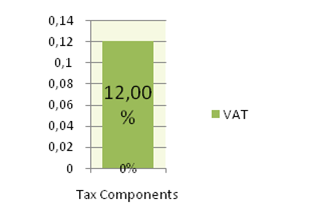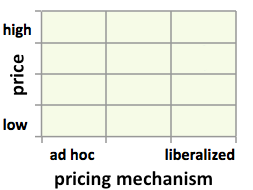Difference between revisions of "Fuel Prices Venezuela"
***** (***** | *****) |
***** (***** | *****) m |
||
| (2 intermediate revisions by one other user not shown) | |||
| Line 1: | Line 1: | ||
{{Fuel Price Factsheet | {{Fuel Price Factsheet | ||
|Fuel Price Country=Venezuela | |Fuel Price Country=Venezuela | ||
| − | |Fuel Pricing Policies="Fuel prices are subsidized and controlled by government, | + | |Fuel Pricing Policies="Pricing policy: Fuel prices are subsidized and controlled by government. Earlier attempts to reform price subsidies were not successful. Since 1996, government has frozen prices, while the official exchange rate has depreciated to one tenth of its value in 1996while the rate on the black market is more than four times the official rate, signaling a very large reduction in fuel prices in real terms. Fuel prices along the border are set higher to discourage out-smuggling. Border filling stations sell fuels at much higher prices except those within the quota. |
| + | |||
| + | Protests: The protests against the sweeping economic reforms in 1989 turned especially violent. The demonstrations started in part in response to a substantial increase in public transportation costs following elimination of fuel price subsidies. The official figure is 276 killed in the aftermath of police and army intervention, but some observers have cited thousands. | ||
| + | |||
| + | PetroCaribe: Venezuela has been operating a regional program, PetroCaribe, since 2005. PetroCaribe has 18 members and 12 joint ventures. In Oct 2011, the president of Venezuela’s national oil company, PDVSA, reported that members received 92,000 bpd of crude oil and petroleum products." | ||
| + | |||
| + | (Source: Kojima, Masami. (2013, forthcoming). “Petroleum product pricing and complementary policies:Experience of 65 developing countries since 2009.” Washington DC: World Bank.) | ||
|Fuel Currency=VEF | |Fuel Currency=VEF | ||
|Fuel Price Exchange Rate=4.2897 | |Fuel Price Exchange Rate=4.2897 | ||
| Line 32: | Line 38: | ||
|Fuel Price Factsheet Source Annotation=Petroleos de Venezuela Sociedad Anonima. PDVSA | |Fuel Price Factsheet Source Annotation=Petroleos de Venezuela Sociedad Anonima. PDVSA | ||
}} | }} | ||
| + | |||
| + | [[Category:Venezuela]] | ||
Latest revision as of 13:46, 13 October 2014
Part of: GIZ International Fuel Price database
Also see: Venezuela Energy Situation
Fuel Pricing Policies
| Local Currency: | VEF |
| Exchange Rate: | 4.2897
|
| Last Update: |
"Pricing policy: Fuel prices are subsidized and controlled by government. Earlier attempts to reform price subsidies were not successful. Since 1996, government has frozen prices, while the official exchange rate has depreciated to one tenth of its value in 1996while the rate on the black market is more than four times the official rate, signaling a very large reduction in fuel prices in real terms. Fuel prices along the border are set higher to discourage out-smuggling. Border filling stations sell fuels at much higher prices except those within the quota.
Protests: The protests against the sweeping economic reforms in 1989 turned especially violent. The demonstrations started in part in response to a substantial increase in public transportation costs following elimination of fuel price subsidies. The official figure is 276 killed in the aftermath of police and army intervention, but some observers have cited thousands.
PetroCaribe: Venezuela has been operating a regional program, PetroCaribe, since 2005. PetroCaribe has 18 members and 12 joint ventures. In Oct 2011, the president of Venezuela’s national oil company, PDVSA, reported that members received 92,000 bpd of crude oil and petroleum products."
(Source: Kojima, Masami. (2013, forthcoming). “Petroleum product pricing and complementary policies:Experience of 65 developing countries since 2009.” Washington DC: World Bank.)
Fuel Prices and Trends
| Gasoline 95 Octane | Diesel | |
|---|---|---|
| in USD* |
|
|
| in Local Currency |
|
|
* benchmark lines: green=US price; grey=price in Spain; red=price of Crude Oil
Note: On 1 January 2008 a new bolivar, the bolívar fuerte (ISO 4217 code VEF), worth 1,000 VEB, was introduced.
Source: http://en.wikipedia.org/wiki/Venezuela#endnote_currencynone
Fuel Price Composition
Price composition for one litre of Gasoline 95 Octane as of 2010/11/01.


Source: http://www.eluniversal.com/2009/03/21/en_eco_esp_venezuela-increases_21A2263443.shtml
At a Glance
| Regulation-Price-Matrix |
| ||||
 |

|

|

| ||
Sources to the Public
| Type of Information | Web-Link / Source |
|---|---|
| Other Information | http://www.claec.org (Latin American Commission of Fuel Companies) |
| Other Information | http://www.mem.gov.ve/ (Ministry of Energy and Mines) |
| Other Information | http://www.pdvsa.com (Petroleos de Venezuela Sociedad Anonima. PDVSA) |
Contact
Please find more information on GIZ International Fuel Price Database and http://www.giz.de/fuelprices



















